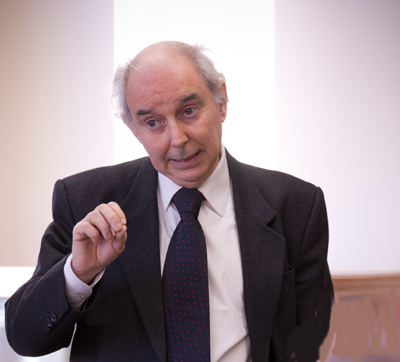Professor Silvio Ferrari Addresses Religion and the Public/Private Divide in Europe

In an event sponsored by the International Center for Law and Religion Studies (ICLRS) of the J. Reuben Clark Law School, Professor Silvio Ferrari spoke at Brigham Young University on Monday, 31 January 2011, on the topic “Religion and the Public/Private Divide in the European Legal Systems.” Professor Ferrari is Professor of Canon Law at the University of Milan and Professor of Church-State Relations at the University of Leuven in Belgium. He is director of the Istituto Ecclesiastico at the University of Milan, and is the founder and president of the International Consortium for Law and Religion Studies (ICLARS). He is widely published in the United States and Europe, especially in the areas of religious multiculturalism and the place of Islam in Western society. He is also a member of the ICLRS Academic Advisory Board.
Professor Ferrari’s address took the form of a description of the traditional place of religion in the public sphere in Europe and an exploration of courses of action that might be taken to adapt to transformations that are occuring everywhere in European society.
Traditionally, explained Professor Ferrari, religion has maintained an important and visible position in the European public sphere. Almost everywhere religion is taught in State schools. In many countries religions are financed by the State, and some countries still have a State religion. This strong public presence is being challenged by two important changes: (1) An increasing number of Europeans are not members of any religion and therefore question the State support of religion. This group seeks to diminish the presence of religion in the public sphere. (2) An increasing number of Europeans follow “new religions” (most prominently Islam) that are unsupported by the State. This group seeks to increase the presence of religion in the public sphere, to include them.
The position of mainstream religions in response to these two trends is often to oppose them both, in order to preserve the traditional privileges. Each State has its own way to deal with this situation, and the result is a “complex and lively debate” about the place of religions and beliefs in the public sphere in Europe. Professor Ferrari identified three basic patterns upon which positions in the debate are constructed:
1. A pattern particularly evident in some Catholic and Orthodox countries and perhaps best typified by Italy and its “crucifix case.” This pattern is based on the conviction that traditional religions can still play a central role in maintaining national identity and cohesion in the face of growing globalization and pluralization.
2. A second, “secular” pattern, exemplified by French laïcité, with its laws banning religious symbols at school and the burqa in public places, is based on the conviction that national identity and social cohesion can no longer be effected by traditional religion and must be secured by religiously and culturally neutral principles – such as liberty, equality, and justice – that everyone can accept. This is the basic posture of the Council of Europe and the European Court of Human Rights.
3. A third pattern is exemplified by the United Kingdom, with its advanced pursuit of a multi-cultural organization of society, supported by its system of common law. “In the task of striking a balance between the different ethnic, religious, and cultural groups co-existing in the British society the courts are guided by the respect of fundamental human rights.”
Noting that each of these models has its limitations, Professor Ferrari recommended using them as starting points, taking what is best within each to re-think the role of religion in Europe going forward, as Europeans face fears of a declining Europe, of lack of confidence in the capacity of traditional constitutional democracies to govern. Professor Ferrari believes that liberal democracy “has sufficient resources to govern the transformations of contemporary society without calling into question the fundamental principles on which it is based.”
The “way out” is through an inclusive not an exclusive neutrality, a re-thinking the notion of a public sphere to make it (a) hospitable to individuals and groups who want to publicly manifest their religion or belief; (b) accessible to all individuals and groups who are ready to accept the plurality, on equal footing, of differing religions and beliefs in the same sphere; and (c) respectful of the internal autonomy of religion and belief communities, as long as the human rights of their members are upheld.
This inclusive approach, concluded Professor Ferrari, “makes it possible to take into account the historical, ethnic, cultural, religious and social specificities of each national community and then may develop into a diversified and sustainable pluralism that is able to accompany the ongoing changes in European society and keep the law in touch with its social and cultural background.”